Alocasia foliage has been celebrated throughout the ages as one of nature’s most fascinating and mesmerizing arts. Since then, the beauty of these aroids has graced homes and public spaces, enhancing the beauty of any landscapes they are in.
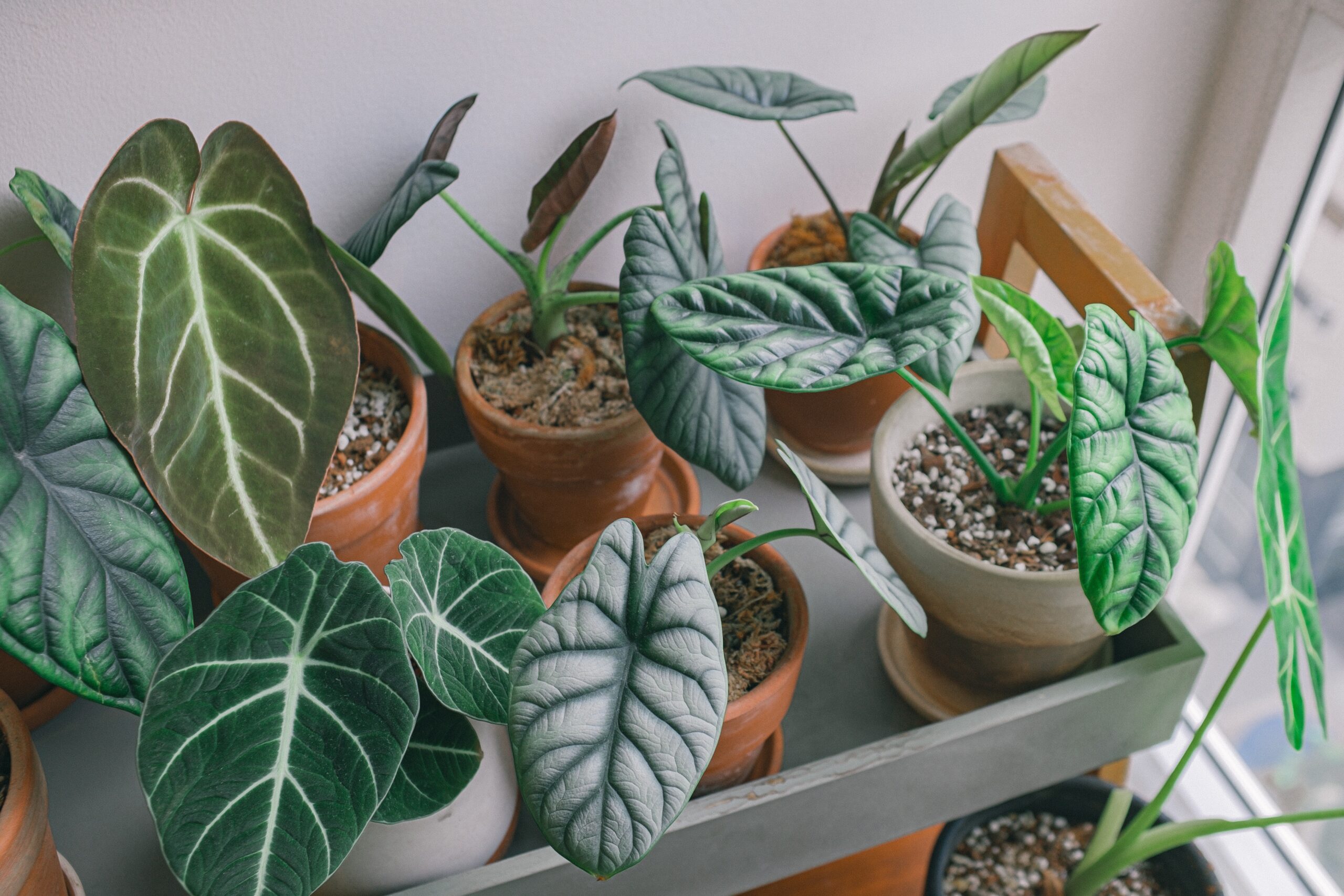
With the vast array of choices of Alocasia plants available in the market, one might ask, what is the best Alocasia to get? Lucky for you because we listed the 28 most trendy Alocasia types that people lose their minds to. Let’s jump right in!
1. Alocasia Rugosa (Alocasia melo)

Alocasia Melo plant has its own unique deeply dark green oval leaves that have unique points at the tip of each leaf. Sometimes, its leaves trick people into thinking it is fake due to its thick appearance that can look like cardboard or even plastic.
Despite this faux look, its leaves nevertheless do not fail to amuse its viewers. It has a heavy texture with a somewhat bluish hue due to its deep, dark green color.
Its stems are thick and sticky, which makes the plant bushy and sturdy in appearance. Undoubtedly an exciting addition to your collection or garden.
2. Black Magic (Alocasia infernalis)

This plant is definitely an eye-catching one due to its almost black, purple leaves. However, it has an intense shimmer with green venation on top of its stunning oval shape and distinctly pointed foliage.
Black magic loves warmth and humidity, so make sure to place it in a mildly warm spot. However, don’t expect it to grow tall compared to other varieties of Alocasia. This dainty plant only grows about 20-22 inches tall.
This variety can survive in light conditions lower than the optimum.
3. Alocasia Black Velvet (Alocasia reginula)
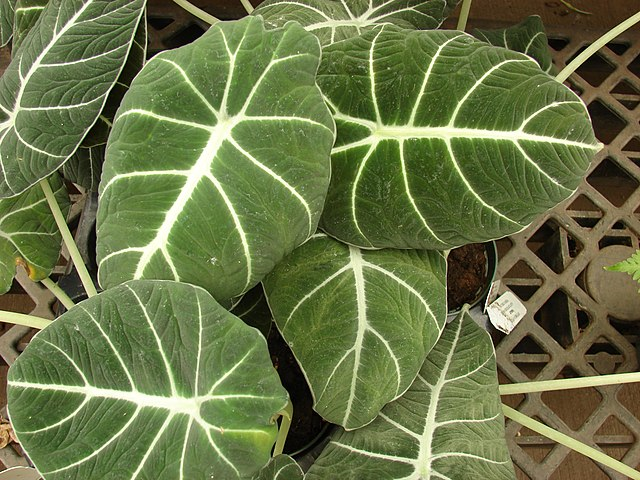
Another mesmerizing, dainty plant is the Alocasia reginula Black Velvet. It is considered often as a mini alocasia since it only grows to about a foot tall. As expected from its name, it has deep, dark green that gives an illusion of ‘blackness’.
Its leaves are also heart-shaped, with succulent white veins and a velvet fabric-like texture.
In addition to its appealing leaves, it also has a silvery green stem, which adds another accent to the small plant.
RELATED: Alocasia Black Velvet: An Instructive Care, Propagation, and Watering Guide
4. Brina (Alocasia zebrina)
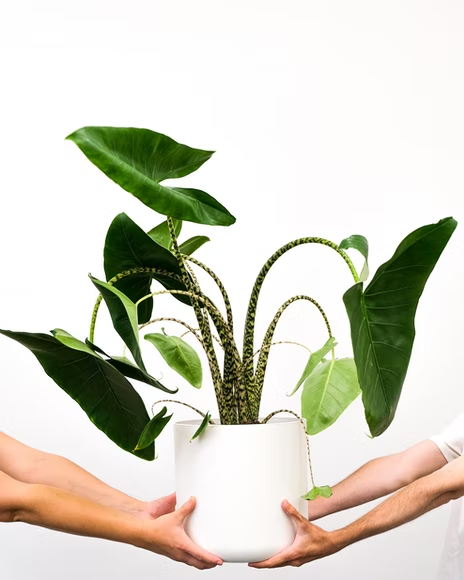
This unique Alocasia has shield-shaped foliage just like the rest of the genus but has distinctive white veins. Another unique feature of this plant is its petioles which are adorned with black and yellow markings, just like a zebra’s print, hence its name.
Its other nicknames include the Alocasia Zebra plant, Alocasia Tiger, or the Leopard Alocasia. Quite understandable due to its striped and spotted pattern on its stem.
Alocasia zebrina can grow to a maximum height and width of about 3 feet.
5. Corazon (Alocasia heterophylla)
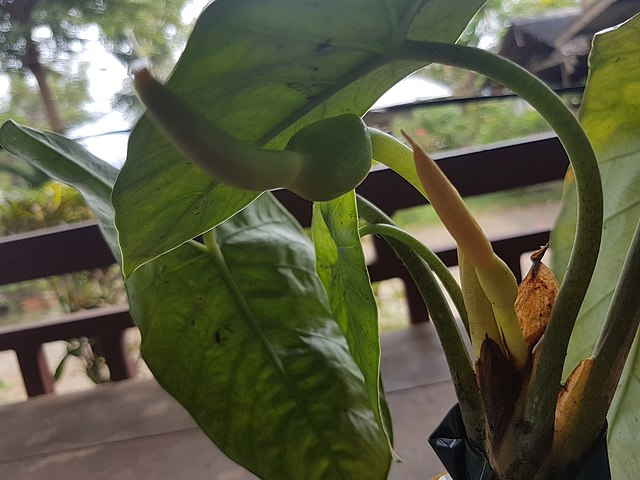
Corazon Alocasia hails from Asia and Australia. It is known for its bluish-green foliage with metallic sheen. This plant is unique and can only have two to three leaves at one time, but they are still very noticeable due to their large size.
The Corazon Alocasia can grow up to a tall 15 feet plant under the optimum tropical conditions, but it usually grows around 3 feet in a home garden. This plant is gardener-approved and recommended due to its low maintenance care and its outstanding characteristics.
6. Dragon Scale (Alocasia baginda)
Another one of the Jewel Alocasia varieties, the Alocasia Dragon Scale, prides its shiny, silvery-green leaves with even darker primary and secondary veins that resemble hardened like scales. Meanwhile, the leaves’ underside is cream with bold burgundy veins.
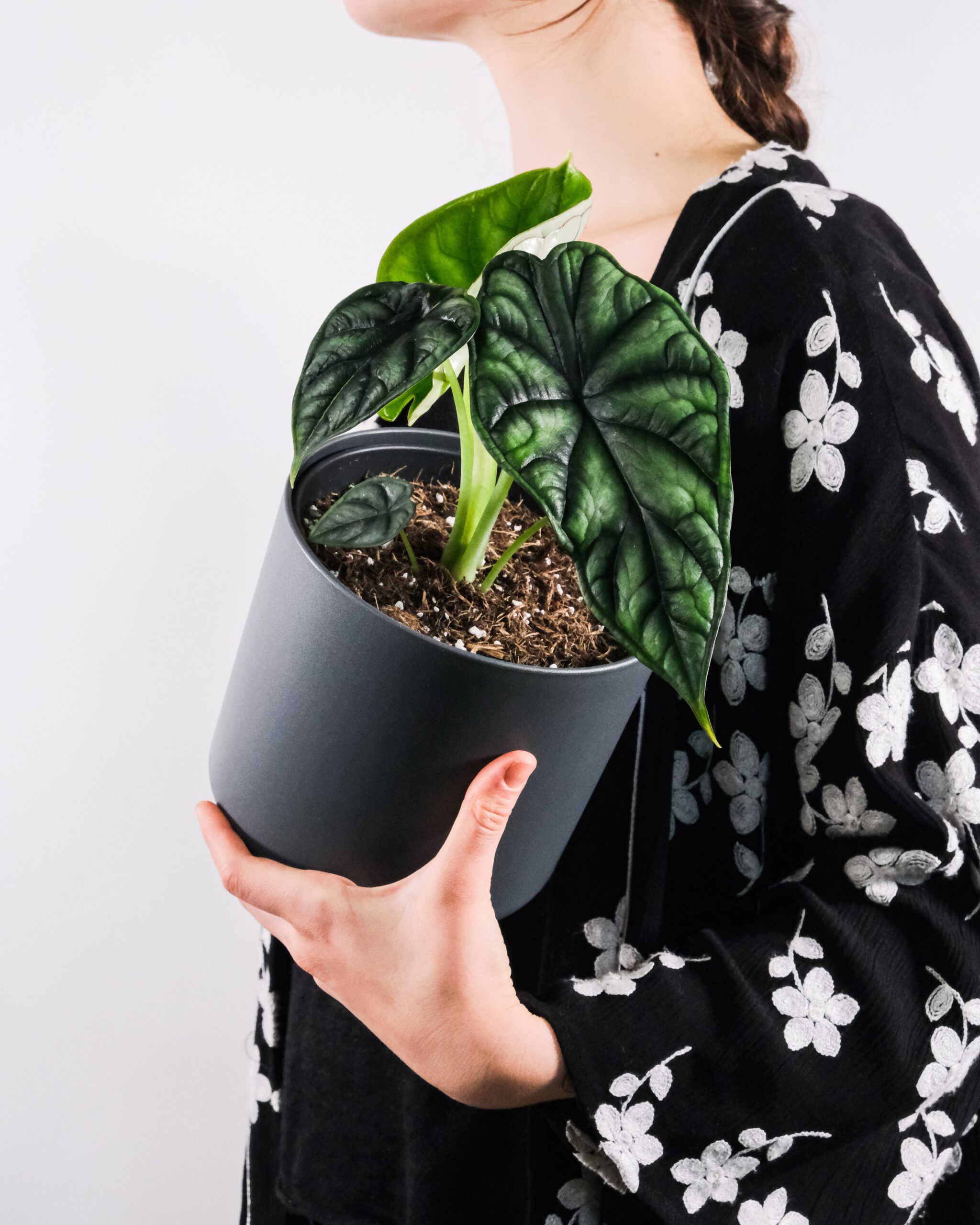
This mystical-looking beauty can grow up to 3 feet in height and about 1.5 feet in width. They are also quite low maintenance as long as they receive enough sunlight and humidity. Perfect for the bathroom or your small home garden.
RELATED: Alocasia Dragon Scale: Your Must-Have Care, Propagation, And Watering Guide
7. Green Velvet (Alocasia micholitziana frydek)

Contrary to its nickname, the Alocasia Green Velvet does not have a fuzzy velvet texture. Nevertheless, it is called green velvet due to its excellent shade of vibrant green which is in contrast with its mild cream-colored veins found on the leaf surfaces.
According to gardeners, they are generally low maintenance provided that your zone is correct. However, this plant is rare, so better hold tight once you get a hold of it!
8. Giant Taro (Alocasia macrorrhizos)
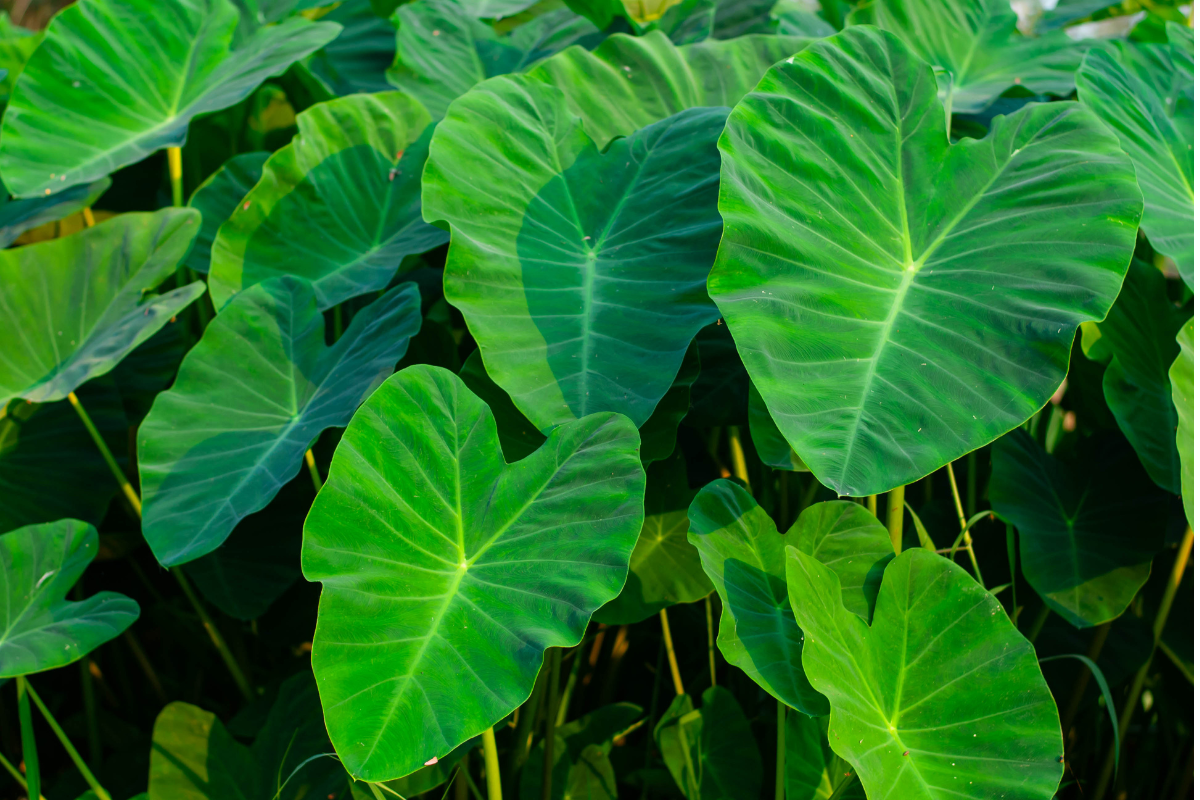
Alocasia macrorrhizos, often confused with A. macrorrhiza, is the marriage of sophistication and simpleness in a plant. This variety of Alocasia is not a taro, however its nickname is due to its similar appearance to the crop vegetable.
This plant grows at a fast speed and large, so always make sure to give it enough space to thrive. This is a perfect addition to your home garden or plant collection if you want a plant that is something clean and classic.
9. Hooded Dwarf (Alocasia cucullata)
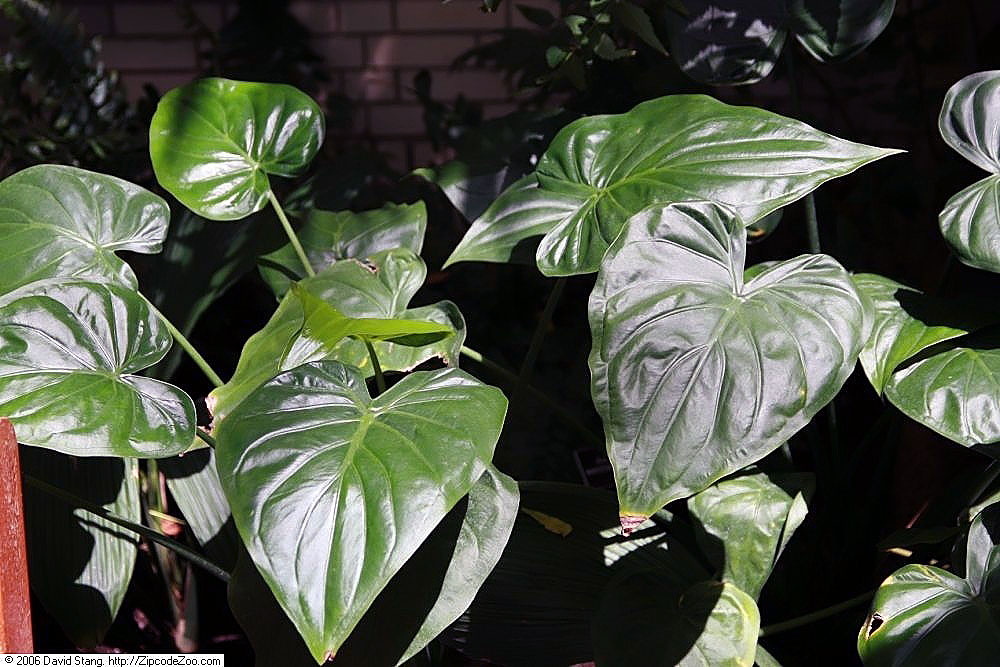
The Hooded Dwarf Alocasia plant, also called the Buddha Hands, is also a relatively fast-growing Alocasia that will flourish in your collection in no time. This has the classic Alocasia look with leaves of various sizes resulting in a shaggy appearance.
Due to this unique feature, this Alocasia looks like a tiny flourishing bush. It is known to get its nickname from one of its uses–tropical medicine in various cultures, especially in Thailand and Laos, which are often seen in Buddhist religious temples.
10. Jewel Alocasia (Alocasia reversa)
This Alocasia plant is among the most trendy varieties of Alocasia due to its easy care and the fact that it is not very hard to get a hand to.
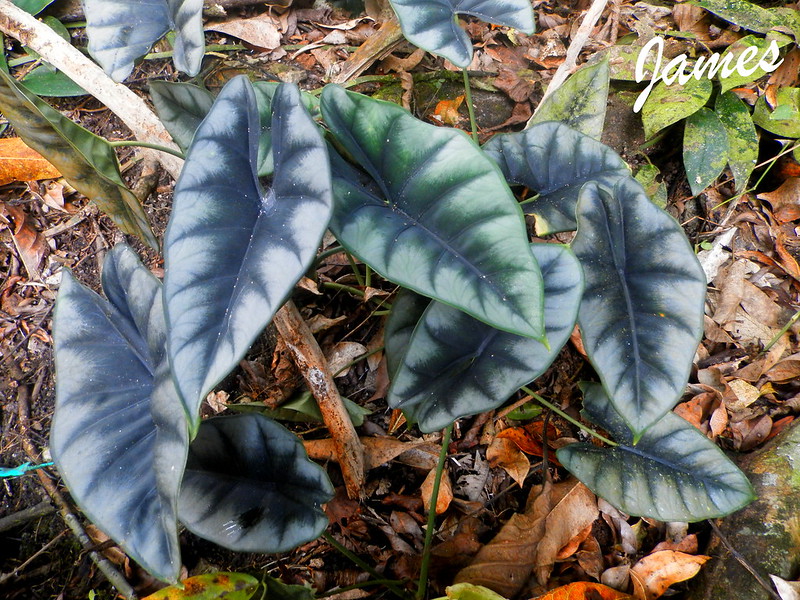
Its leaves are a good shade of green, but some have a silvery-gray coloration. Oftentimes, the venation also differs, precisely a purplish or bluish color that adds extra character to this plant.
Keep in mind that these plants love humidity, so it is best to keep the air at a moist level if you intend to keep it inside your homes.
11. Malaysian Monster (Alocasia portei)
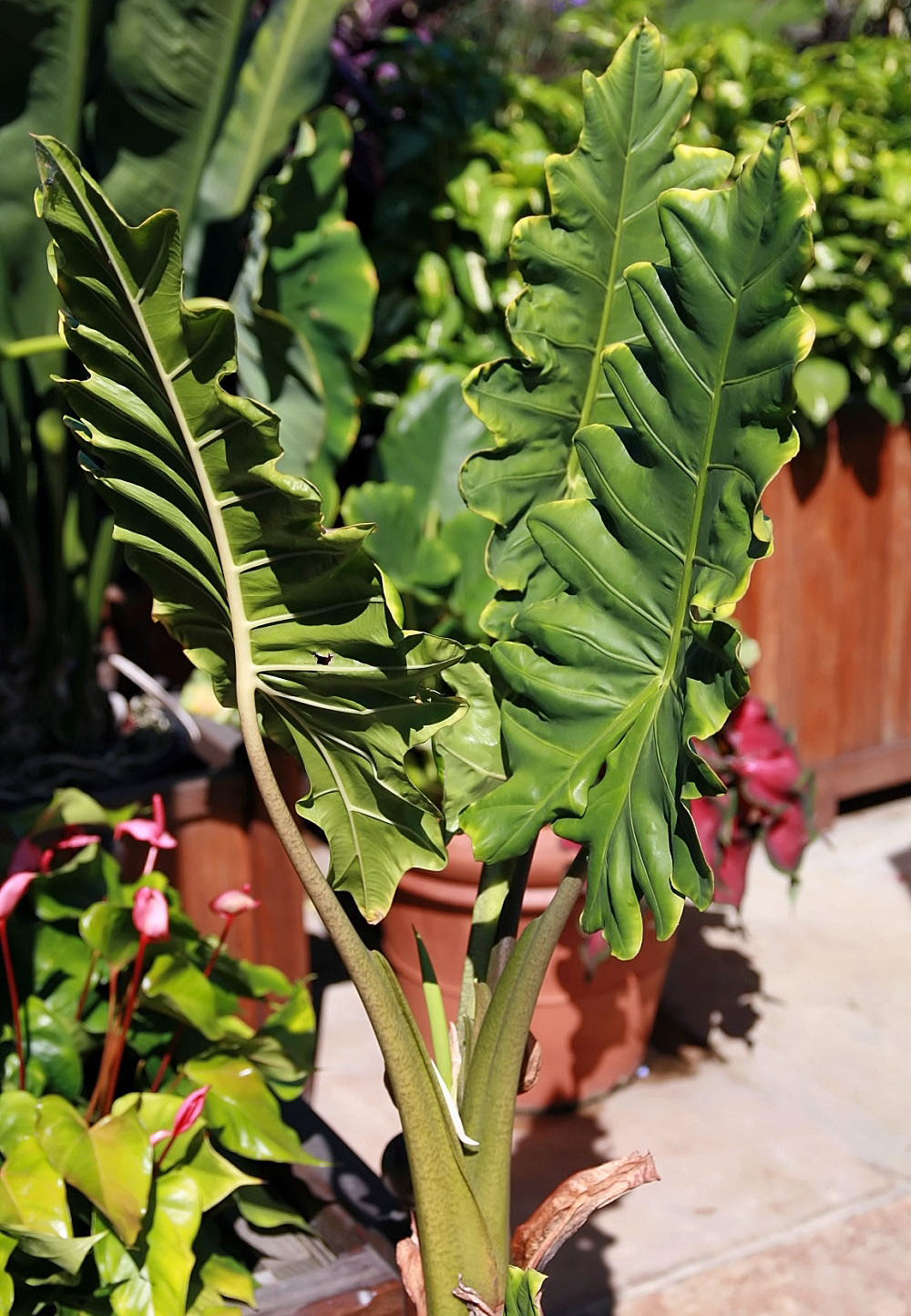
Malaysian Monster Alocasia is a small, slow-growing Alocasia. Contrary to its name ‘monster’, which is often associated with a considerable size, this plant is mid and only grows up to 4-8 feet tall.
Its leaves are unique as they don’t conform to the usual heart-shaped or oval Alocasia leaf. Instead, its leaves are jagged, resembling long teeth that are skinny and narrow. These are exotic-looking varieties which is why they are widely sought after.
12. African Mask (Alocasia sanderiana)

The African mask plant or Kris plant is definitely a people’s favorite. It has large dramatic leaves with thinly white venations that run through the dark green leaves–a perfect contrast.
Its leaves have wavy edges, which makes it distinct for this variety while still maintaining the broad heart-shaped leaves of Alocasia.
13. Miri (Alocasia reginae)
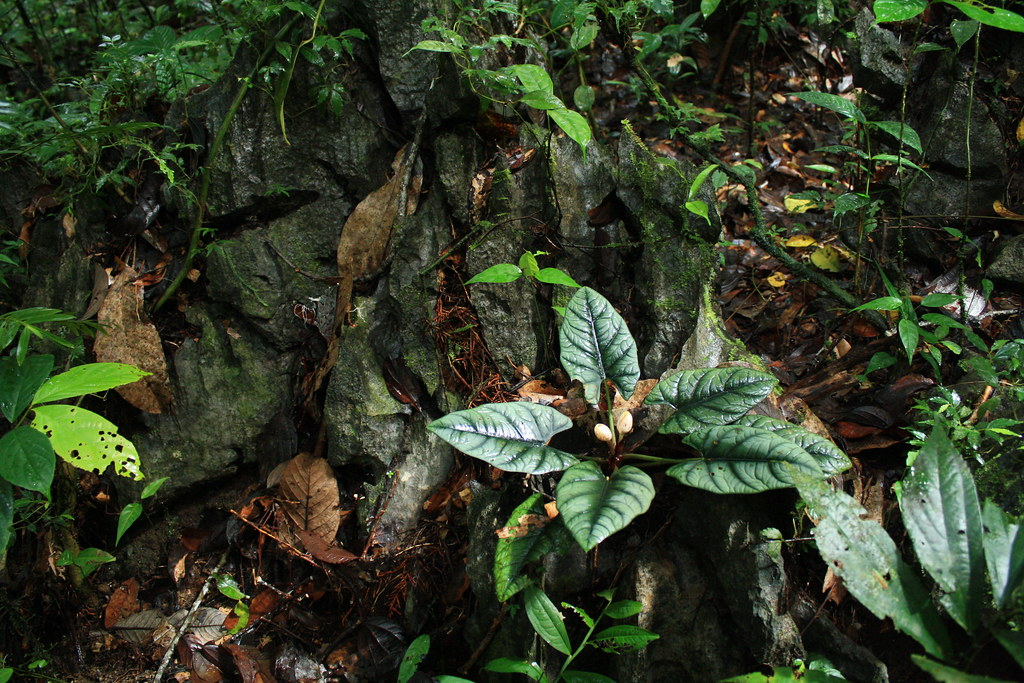
Miri is probably one of Alocasia types that will scream tropical. Its leaves are large, rounded arrow shape that sometimes droops–making it a dramatic accent to your garden. The underside of it has red hues, which definitely makes a statement.
Its stems are usually long and slender, but they still support the large leaves, just like what you would likely observe in their natural habitats, the tropical forests.
14. Night-scented Lily (Alocasia odora)
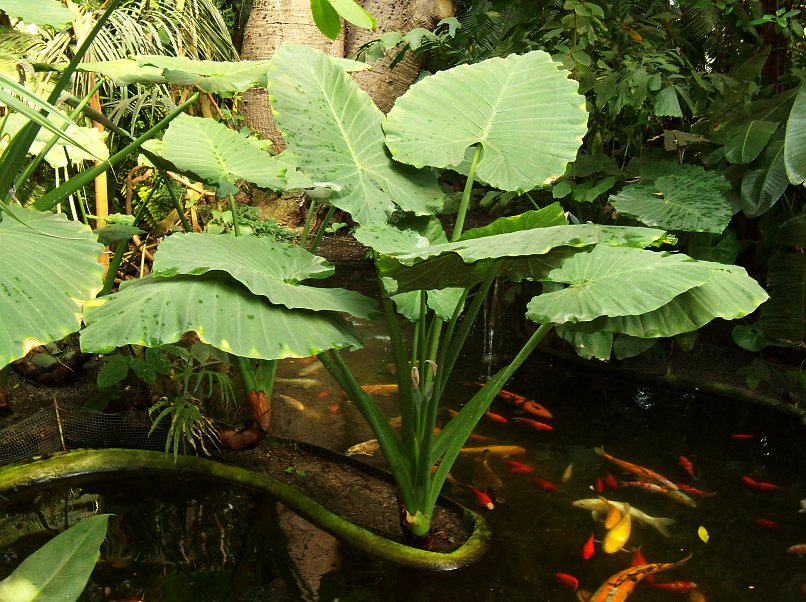
One of the most outstanding features of the Night Scented Alocasia odora is probably the color of its foliage. It has different shades of cream and green, which makes it resemble an abstract painting that is oil-based.
Aside from this, its leaves are typical elephant ear-shaped, that are large, and tend to have an upward growth, making it look ever thriving and healthy.
They are also low maintenance, especially when they are kept indoors. These are perfect if you are looking for a plant that will bring some subtle odor and charisma into your houses.
15. Nigra (Alocasia plumbea)
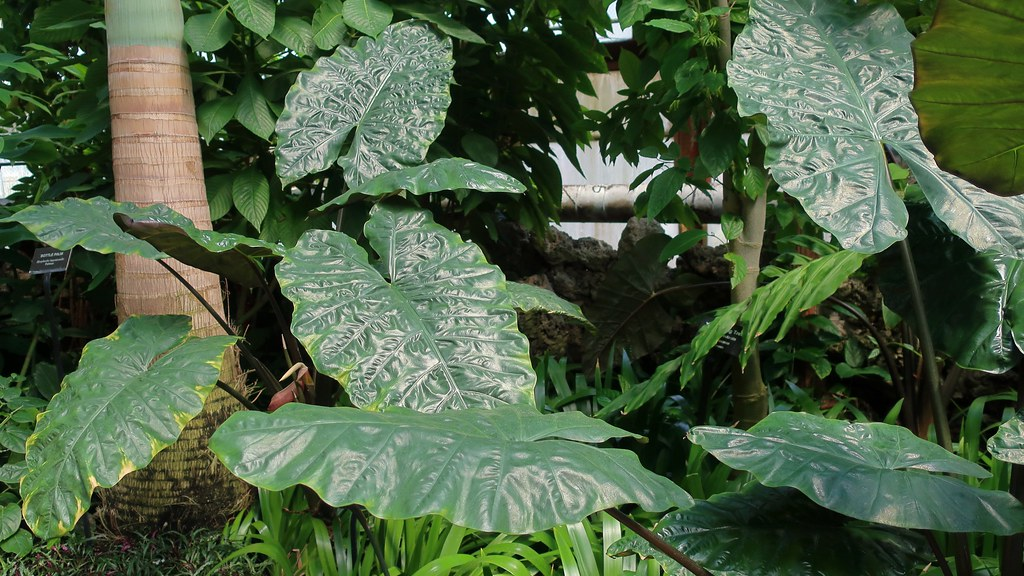
The Alocasia Nigra plant, aka Black Metallic Taro, is a stunning and a modernesque plant due to its lovely monochromatic color. In addition, the leaves and the stem have the similar color, which makes it simple yet elegant.
This plant grows up to 3-6 feet, so it can be placed both outdoors and indoors with hefty amount of space. This plant, however, loves to be in partly shaded areas as direct and extended sunlight can burn and dry its leaves out.
So always try not to dry this plant too much and make sure always to keep it hydrated and moist.
16. Pink Passion (Alocasia brancifolia)
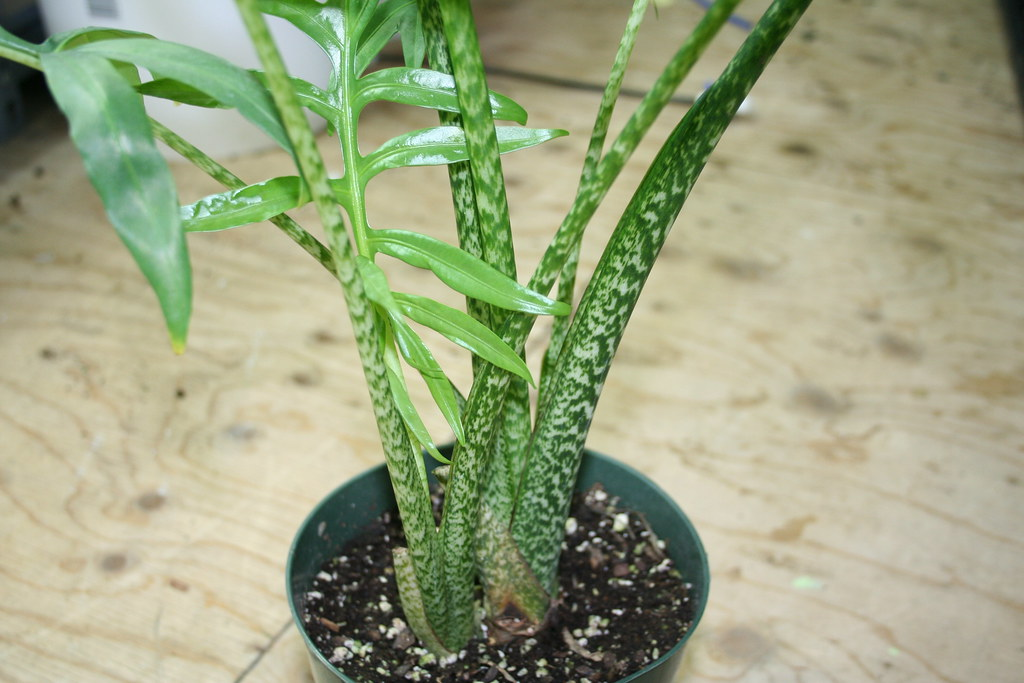
Pink passion Alocasia is one of the rare Alocasias, which makes it highly in demand. This plant is unique in a way that its leaves have scooped and pointed edges, resembling an elongated maple leaf.
The color is also a vibrant green, with a silky, smooth texture.
Another reason why this plant is in demand is due to its low maintenance care. This is another gardener’s favorite and recommendation.
Keep in mind, though, that its leaves are highly toxic. Keep them away from pets and small children.
17. Polly Plant (Alocasia amazonica)
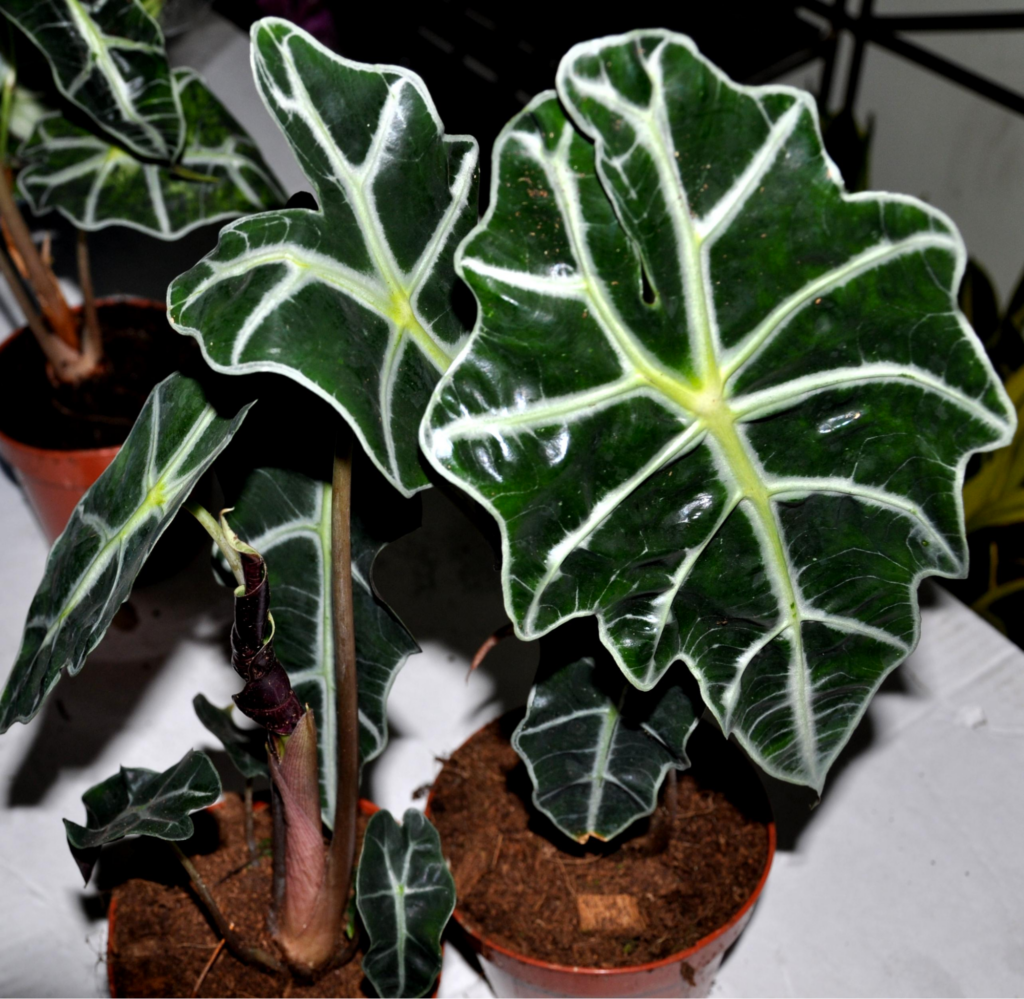
Hailing from Southeast Asia, the Polly Alocasia plant is also one of the most common, easy to care for, and grow varieties of Alocasia. This plant is highly resilient and sturdy and can withstand less than optimum conditions for an extended period before its vitality declines.
It has a strong stem that upholds its exotic, dark green leaves outlined by bright cream-white veins. This plant definitely makes a statement by showing a stark difference from other lightly green colored plants in your own spaces.
RELATED: How To Care For Alocasia Polly? All the Questions And Answers You Need
18. Purple Umbrella (Alocasia wentii)
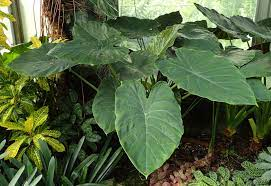
Contrary to its nickname, Purple Umbrella is nowhere near purple, but instead has a distinct grayish underside that gives a purple illusion when sunlight strikes it. Sometimes, it also gives a reddish hue, making it even more unique.
Its leaves are oval-shaped that are flared upwards, seemingly designed to catch rain and let it go directly to the soil and roots, hence its name. The stems are also thick and luscious and can be up to 10-16 inches tall.
19. Red Secret (Alocasia cuprea)
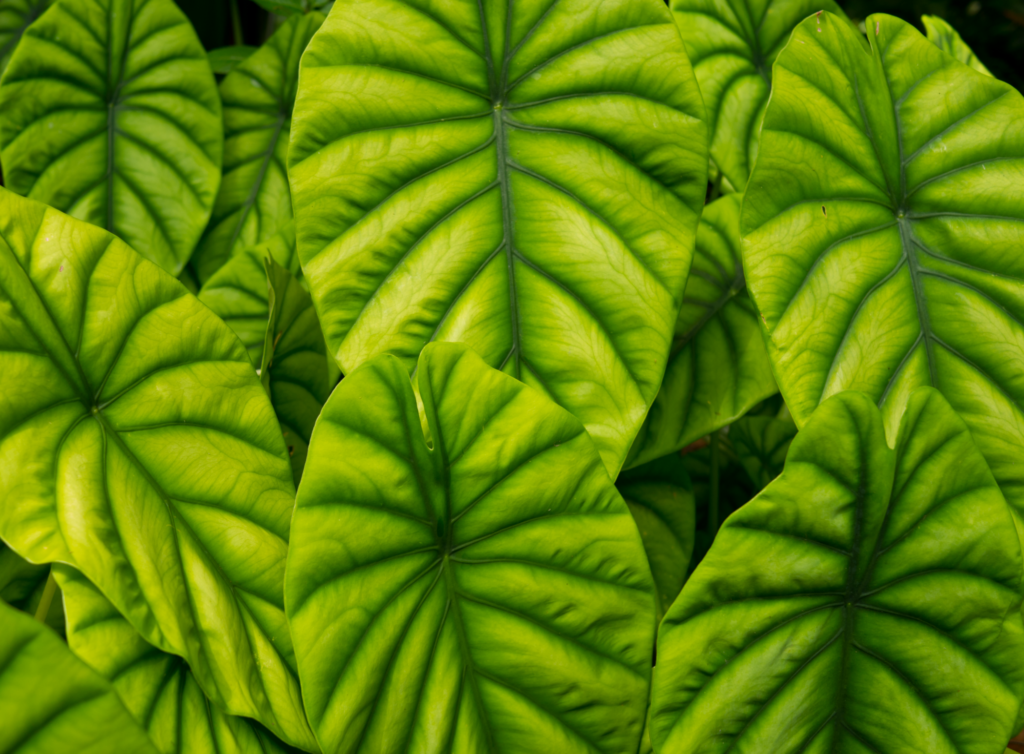
This Alocasia has one of the most exciting colors out of the numerous varieties. The colors of this gem can range from fiery orange with purple and red undertones to deeply green foliage.
Sometimes, the leaves can be so darkly green that they almost seem black, with features of red and orange along the plant’s stem.
This plant can grow up to 3-4 feet tall, and its leaves are few inches in length, adding more volume to the plant. This plant will surely add delightful surprises to your life because, in a way, you never know what it will look like when it grows.
20. Samar (Alocasia scalprum)
Another distinct variety of Alocasia, Samar has dagger-like-shaped, sharp leaves that also have a vibrant green color with a gentle sheen. Its leaves seem to be embossed due to their wonderful venation and have its tender, thin stems.
Yet, even with its understated look, it gives personality to whatever space it is in due to its petite appearance.
Unfortunately, this variety is very susceptible to plant diseases and pests, so it needs extra love and care to thrive. Usually, it is easier to tend for them indoors, where you are more in control of the environment and other factors.
21. Silver Dragon (Alocasia baginda)
This variety of Alocasia is same-looking but slightly dissimilar from the also-known Dragon Scale variety. This plant has a more apparent silvery color and grows out more leaves as compared to the Dragon Scale Alocasia.
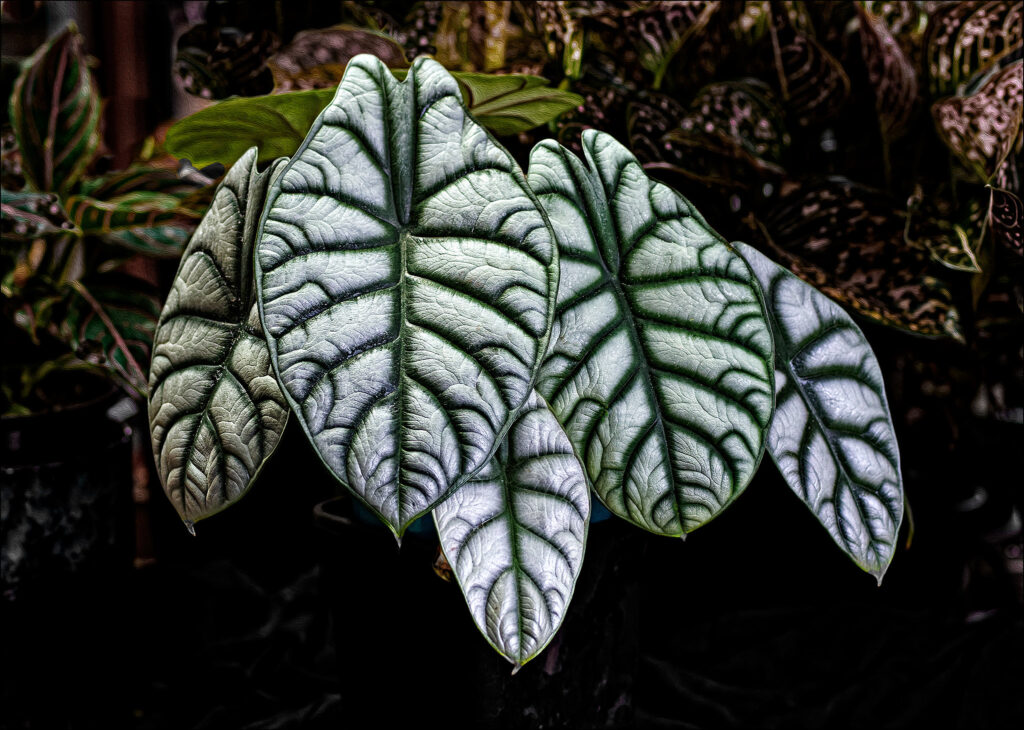
In addition, its leaves have a darkish green outline and venation, creating a shadowing effect.
These plants can grow tall and large (3-4 feet), but they don’t need much space to have a flourishing growth as their roots are pretty shallow.
22. Silver Plant (Alocasia nebula)
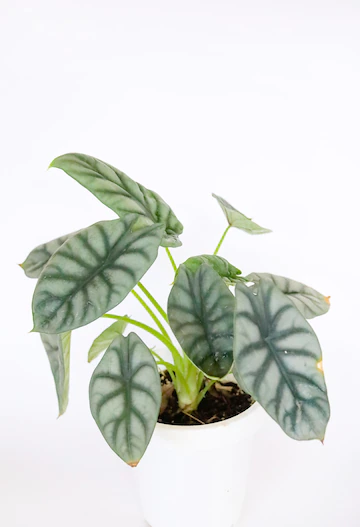
As you can infer from the name, the silver plant has silvery foliage that may come off as plastic or artificial to some.
In addition, they have thick leaves that are kind of puffy, makings them look unrealistic. While this Alocasia plant is a rare find, it is an easy-to-care plant as it does not crave a lot of water or light.
Under certain environmental conditions, this plant can appear grayish-blue, perfect if you’re looking for an accent or standout in your sea of green garden.
23. Stingray (Alocasia macrorrhiza)
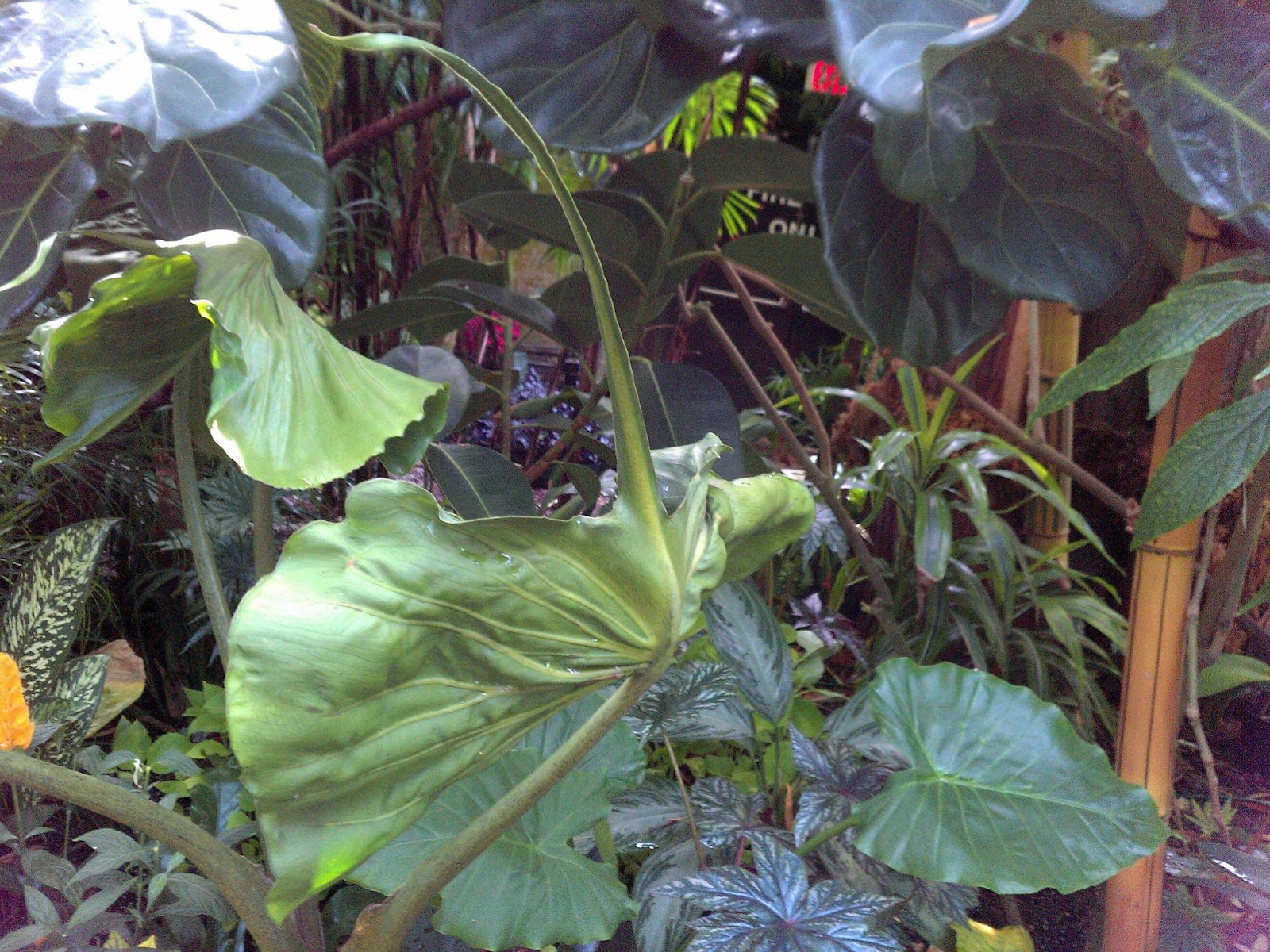
Another popular variety due to its exotic and unique ornamental leaves. Its name is actually adapted from its dazzling foliage that are rounded and wide with a slender tail found at the tip.
The tail is definitely resembling that of a stingray. So if you aim to impress other people with a fun plant, the stingray will be more than equipped to do that job.
24. Tiger Taro (Alocasia longiloba)
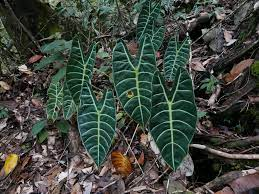
The Alocasia tiger Taro definitely has its leaves as its best features–beautiful dark green in color with distinct bright green or white, cream-colored veins.
This truly creates a unique striped pattern, hence its name. Another reason for its nickname is that it is among the most steadfast and resilient species of Alocasia.
Another good thing, this plant is very low maintenance. In no time, this plant will flourish to add more depth and volume to your collection.
25. Yucatan Princess (Alocasia sarawakensis)
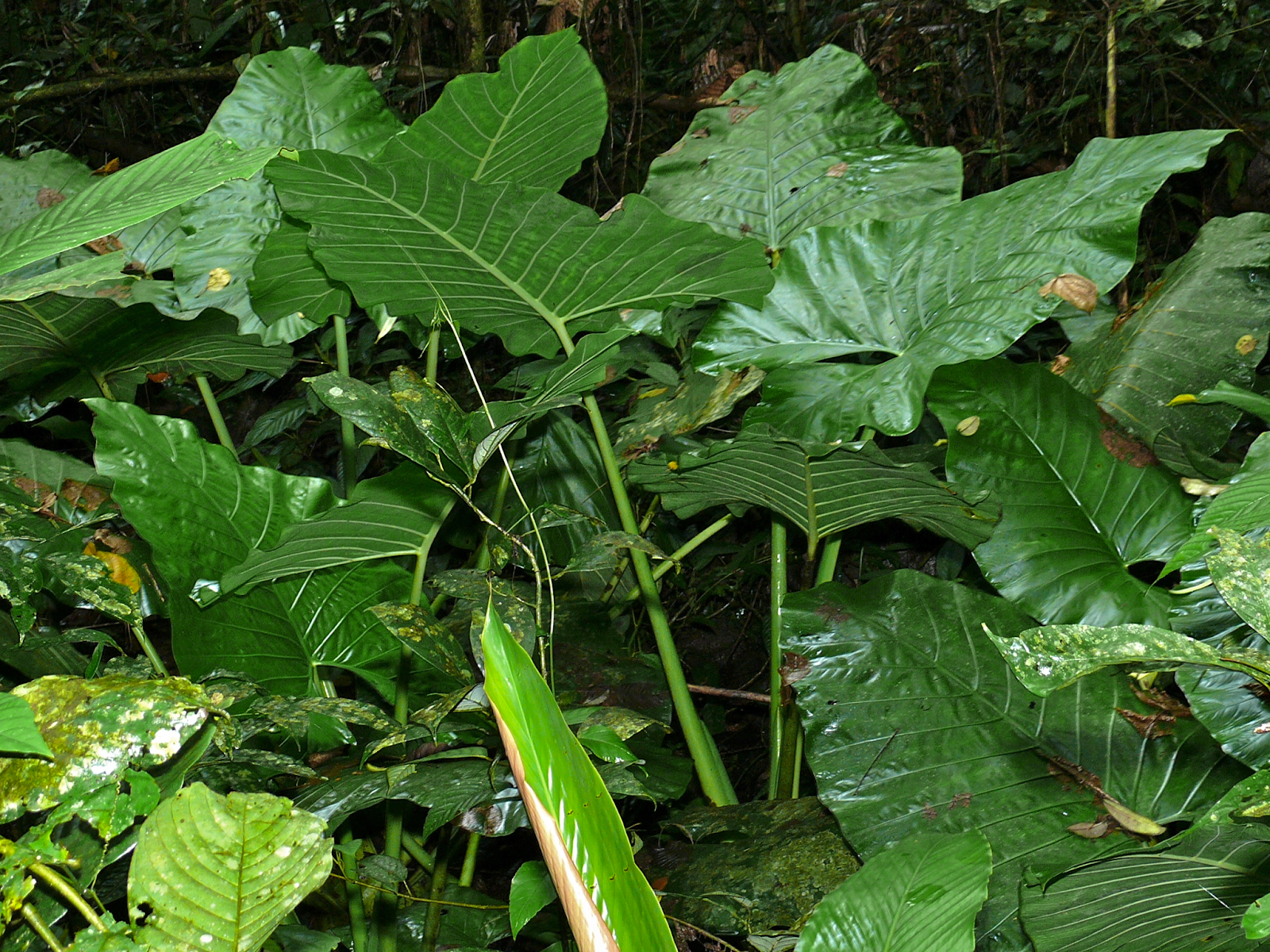
Usually, Alocasias are named after royalties due to their regal qualities. The Alocasia Yucatan Princess, for instance, has stems that grow very high which hold big foliage in a distinctly horizontal way. Its leaves are very leather-like and have a glossy sheen, just like its family members.
The Alocasia Yucatan Princess is the perfect plant that would give your home a tropical but modern bump.
26. Zebrina Reticulata (Alocasia zebrina ‘Reticulata’)

This is another cultivar of the Zebrina plant, which is a plant that has a zebra print-like pattern and stripes on its petioles. However, this cultivar is different because of the additional distinct leaf reticulation–an interlacing pattern that resembles a net, hence the name.
This rare variety reaches up to 3 feet in height and width.
27. Purple Sword (Alocasia lauterbachiana)
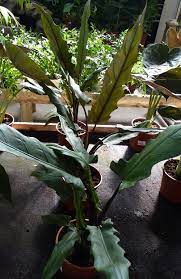
From its appearance, it is pretty apparent where its name came from–it has long, narrow leaves with scalloped edges reminiscent of a sword. Its top side is glossy green, while the underside has a coppery, purple hint.
Most mature purple sword plants grow up to 3 to 4 feet tall and wide.
28. Flying squid (Alocasia plumbae)
While we’re talking about long and narrow leaves, any Alocasia plant’s leaves could not get any narrower than this beauty. In addition, the flying squid has wildly curved petioles resembling squid arms with tiny pointed leaves at the end of the tubular stalks.
This plant is one of the dainty Alocasias as it only grows 12 inches tall. Unfortunately, it also has a short lifespan, averaging at five years.
Closing Remarks
Alocasias or Elephant Ears are beautiful plants with huge, distinctive leaves of varying colors and patterns flowing beautifully over their tall, long stems. They are excellent houseplants that beautify your indoor landscapes and work well as outdoor landscaping plants in warm, humid regions.
Indeed, Alocasia plants are to die for. With this list, we hope you get to choose what Alocasia plants to add to your collection! If not yet, why not get them all?
FAQS
Are Alocasias hard to care for?
Generally, Alocasia plants are not the easiest to care for, but surely not the hardest. Depending on the type of Alocasia, the plant needs reasonable care and attention to thrive and could be a little fussy when the environment is not at its optimum. However, first-time plant collectors can surely have these plants in their homes.
Should I cut off Alocasia flowers?
It depends on you. You can leave the flower and admire its rare beauty. However, flowers take much energy from the plant, and thus often, flowering involves the dropping of some leaves. Cut the flowers off if you care for much healthier foliage and faster new growth, especially in the growing season.
How often should you water Alocasias?
Alocasias can be very water sensitive. Therefore, it is imperative to water them only once during cold seasons and up to three times a week during hot seasons. As a general rule, you may check the top 3 inches of soil and only water when it is scorched. Overwatering causes too moist conditions that will invite more spider mites and microorganisms.
Do Alocasias bloom?
As an angiosperm, Alocasias produce an anthurium-like flower called a spadix. However, the flowers of Alocasias are insignificant as they rarely bloom. They are collected mainly by their distinct foliage.
What soil do Alocasias need?
A well-draining soil that contains large chunks which are suitable for aeration and drainage is generally what Alocasias love. A standard jungle or aroid mix will surely make your Alocasia plants thrive.
We hope you learned something from this article, here are other articles that you can learn from:
Snake Plant Roots: What To Look For In A Healthy Sansevieria Plant
Watering Snake Plants: How Often To Water And More Helpful Tips







